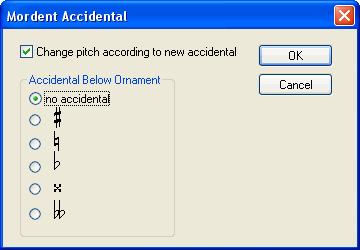|
<< Click to Display Table of Contents >> Editing Mordents |
  
|
|
<< Click to Display Table of Contents >> Editing Mordents |
  
|
A mordent, indicated with the ![]() or
or ![]() symbol above the ornamented note, is performed as two notes preceding the final performance of the ornamented note The first note of the mordent has the pitch of the ornamented note. The second note is a half step or whole step above or below the note. The more common mordent, represented with the
symbol above the ornamented note, is performed as two notes preceding the final performance of the ornamented note The first note of the mordent has the pitch of the ornamented note. The second note is a half step or whole step above or below the note. The more common mordent, represented with the ![]() symbol, plays the second note below the ornamented note. The mordent represented with the
symbol, plays the second note below the ornamented note. The mordent represented with the ![]() symbol plays the second note above the ornamented note.
symbol plays the second note above the ornamented note.

In the Ornament Palette, the buttons for the two types of mordents look like this:
![]() and
and ![]()
The following general procedures apply to the editing of mordents:
| Adding Ornaments. The Adding Ornaments procedure explains how you can specify the duration of the mordent members, such as 32nd notes or 16th triplets. |
The following procedures, unique to mordents, are described in this topic:
| Change the type of mordent, that is, whether the mordent plays a note below or above the ornamented note. |
| Add an accidental for the note above or below the ornamented note. |
![]() To change the type of mordent.
To change the type of mordent.
| 1. | Select the mordent symbol in the score. |
| 2. | Click the |
-- OR --
Type "md" or "mu" for downward or upward mordent.
Composer will change not only the symbol but also the performance of the mordent.
A mordent can optionally have an accidental for the note above or below the ornamented note. This accidental is displayed below the ![]() symbol or above the
symbol or above the ![]() symbol. The ornament accidental is necessary only if the upper or lower note of the mordent does not fall within the key signature, or if in the same measure there is a previous note that would change the inherited accidental for the upper or lower note of the mordent.
symbol. The ornament accidental is necessary only if the upper or lower note of the mordent does not fall within the key signature, or if in the same measure there is a previous note that would change the inherited accidental for the upper or lower note of the mordent.
![]() To add an accidental for the upper and/or lower note of a mordent:
To add an accidental for the upper and/or lower note of a mordent:
If the mordent has not already been added, then add it, as described in Adding Ornaments. You always add an accidental to an ornament after the ornament has been added.
| 1. | In the Ornament Palette, click the Edit Accidental |
-- OR --
Type "ac" for accidental.
Composer will display the Mordent Accidental dialog box:

| 2. | Enter the accidental for the note below or above the ornamented note, depending on whether the mordent symbol is |
| 3. | If you want the accidental to apply to the actual performance-- which you usually will want to do-- then leave a check mark by "Change pitch according to new accidental." |
